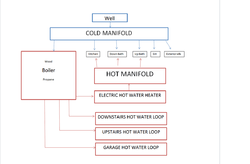- Jan 30, 2013
- 32
Located in CT. 1890's era early farm house with a small field stone foundation with the rest of the basement crawl space. I only have one flue available to me.
I would like to replace my aging oil boiler (steam heat) two pipe system with a wood boiler with a propane burner backup. Looking at the BioMass 40 wood gasification boiler with propane backup. (finished the propane retrofit last year. I have a few questions regarding the best way to deliver the heat. I attached a word doc. with a basic layout of how I would like to set this up.
1: Reading about hot water heat delivery options...Radiant floor heat is not an option right now since I am not going to rip up the floors. If I add water storage at about 190F then I would want a hot water delivery system that is about 100-110F to maximize the amount of BTU's stored correct? As I understand hot water baseboard usually operates at about 180F? please correct me if this is incorrect. What would be the best hot water delivery option in this case?
2: Thermal Storage. I plan on doing this retrofit in stages. I would first like the remove the old system (oil tank, boiler, pipes & radiators; and replace with the biomass boiler and new delivery system. Because of the small basement I do not have room for water storage, However in the next few years I plan on building a detached garage with a separate heated shop area that I could incorporate hot water storage tanks into. Can the storage tanks be piped into the system through underground insulated pipes?
3: Gravity vs circulator pump system. We had a pretty bad ice storm that left us without power last year and with having unlimited access to firewood, I would like the system to run without electricity for emergency situations. Can someone explain how a system like this works? I asked my boiler guy about them and he said he has serviced them but never installed such as system. Is it possible to run a gravity system (with expansion tank in attic) inline with a circulation pump to increase pressure for DHW?
Thanks for the advice.

I would like to replace my aging oil boiler (steam heat) two pipe system with a wood boiler with a propane burner backup. Looking at the BioMass 40 wood gasification boiler with propane backup. (finished the propane retrofit last year. I have a few questions regarding the best way to deliver the heat. I attached a word doc. with a basic layout of how I would like to set this up.
1: Reading about hot water heat delivery options...Radiant floor heat is not an option right now since I am not going to rip up the floors. If I add water storage at about 190F then I would want a hot water delivery system that is about 100-110F to maximize the amount of BTU's stored correct? As I understand hot water baseboard usually operates at about 180F? please correct me if this is incorrect. What would be the best hot water delivery option in this case?
2: Thermal Storage. I plan on doing this retrofit in stages. I would first like the remove the old system (oil tank, boiler, pipes & radiators; and replace with the biomass boiler and new delivery system. Because of the small basement I do not have room for water storage, However in the next few years I plan on building a detached garage with a separate heated shop area that I could incorporate hot water storage tanks into. Can the storage tanks be piped into the system through underground insulated pipes?
3: Gravity vs circulator pump system. We had a pretty bad ice storm that left us without power last year and with having unlimited access to firewood, I would like the system to run without electricity for emergency situations. Can someone explain how a system like this works? I asked my boiler guy about them and he said he has serviced them but never installed such as system. Is it possible to run a gravity system (with expansion tank in attic) inline with a circulation pump to increase pressure for DHW?
Thanks for the advice.


